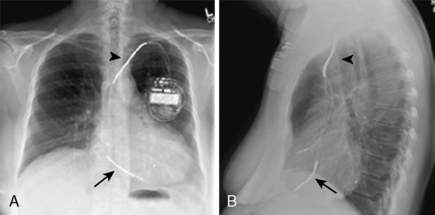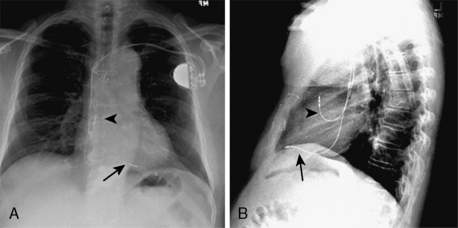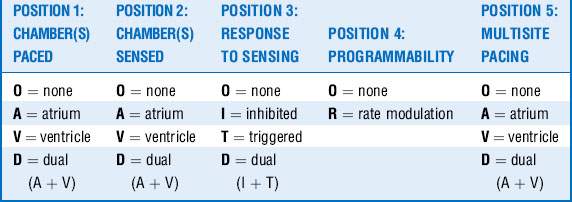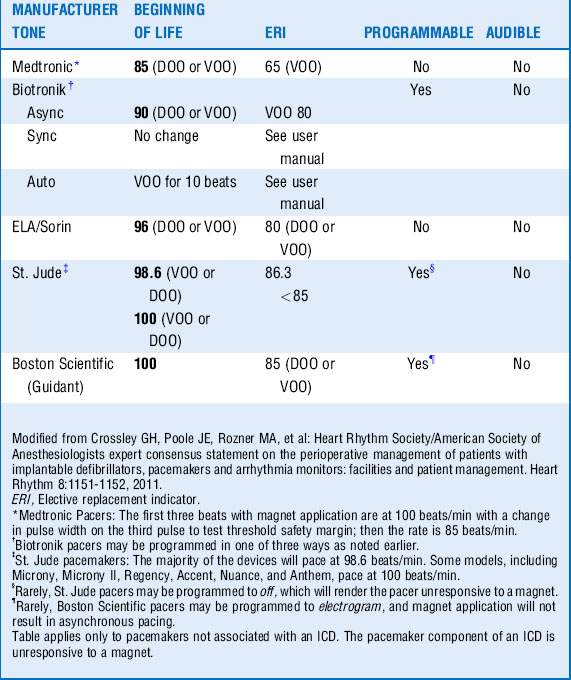Chapter 18 Pacemakers and Defibrillators
1 What are the general principles of cardiovascular implantable electronic device (CIED) management according to the Heart Rhythm Society (HRS)–American Society of Anesthesiologists Consensus Statement published in 2011?
2 How can one differentiate a pacemaker from an ICD?
Occasionally a patient is seen initially without information about his or her CIED. A critical step is to determine whether the device is a pacemaker or an ICD. The patient may be able to tell you why the device was inserted, and this might provide a clue. However, if the patient’s history cannot help, the patient’s chest radiograph can. The ICD leads, unlike pacer leads, have one or two radiodense shocking coils. Because of the shocking coils, the ICD leads (Fig. 18-1) are much larger than the pacer leads (Fig. 18-2), and this can be appreciated radiographically.
3 Describe the five-letter pacemaker code
• First position of the code reflects the chamber(s) in which stimulation occurs.
 Second position refers to the chamber(s) in which sensing occurs.
Second position refers to the chamber(s) in which sensing occurs.
 Third position refers to the mode of setting (or how the pacemaker responds to a sensed event).
Third position refers to the mode of setting (or how the pacemaker responds to a sensed event).
 Fourth position reflects rate modulation.
Fourth position reflects rate modulation.
 Fifth position of the code indicates whether multisite pacing is present.
Fifth position of the code indicates whether multisite pacing is present.
5 Explain the following pacemaker codes: DOO, VVI, DDD, and DDDRV
 DOO = asynchronous atrial-ventricular pacing with a constant A-V interval. Atrial and ventricular pacing pulses are emitted regardless of the underlying cardiac rhythm.
DOO = asynchronous atrial-ventricular pacing with a constant A-V interval. Atrial and ventricular pacing pulses are emitted regardless of the underlying cardiac rhythm.
 VVI = ventricular-only antibradycardia pacing. Failure of the ventricle to produce an intrinsic event within the appropriate time window results in ventricular pacing. With no atrial sensing, there can be no atrioventricular (AV) synchrony in a patient with any intrinsic atrial activity.
VVI = ventricular-only antibradycardia pacing. Failure of the ventricle to produce an intrinsic event within the appropriate time window results in ventricular pacing. With no atrial sensing, there can be no atrioventricular (AV) synchrony in a patient with any intrinsic atrial activity.
 DDD = dual-chamber antibradycardia pacing. In the absence of intrinsic activity in the atrium, it will be paced. After any sensed or paced atrial event, an intrinsic ventricular event must occur before the expiration of the AV timer or the ventricle will be paced.
DDD = dual-chamber antibradycardia pacing. In the absence of intrinsic activity in the atrium, it will be paced. After any sensed or paced atrial event, an intrinsic ventricular event must occur before the expiration of the AV timer or the ventricle will be paced.
 DDDRV = dual-chamber antibradycardia pacing with rate response mode circuitry (to increase the paced rate in setting of increased metabolic demand) and biventricular pacing capability.
DDDRV = dual-chamber antibradycardia pacing with rate response mode circuitry (to increase the paced rate in setting of increased metabolic demand) and biventricular pacing capability.
< div class='tao-gold-member'>

Full access? Get Clinical Tree










